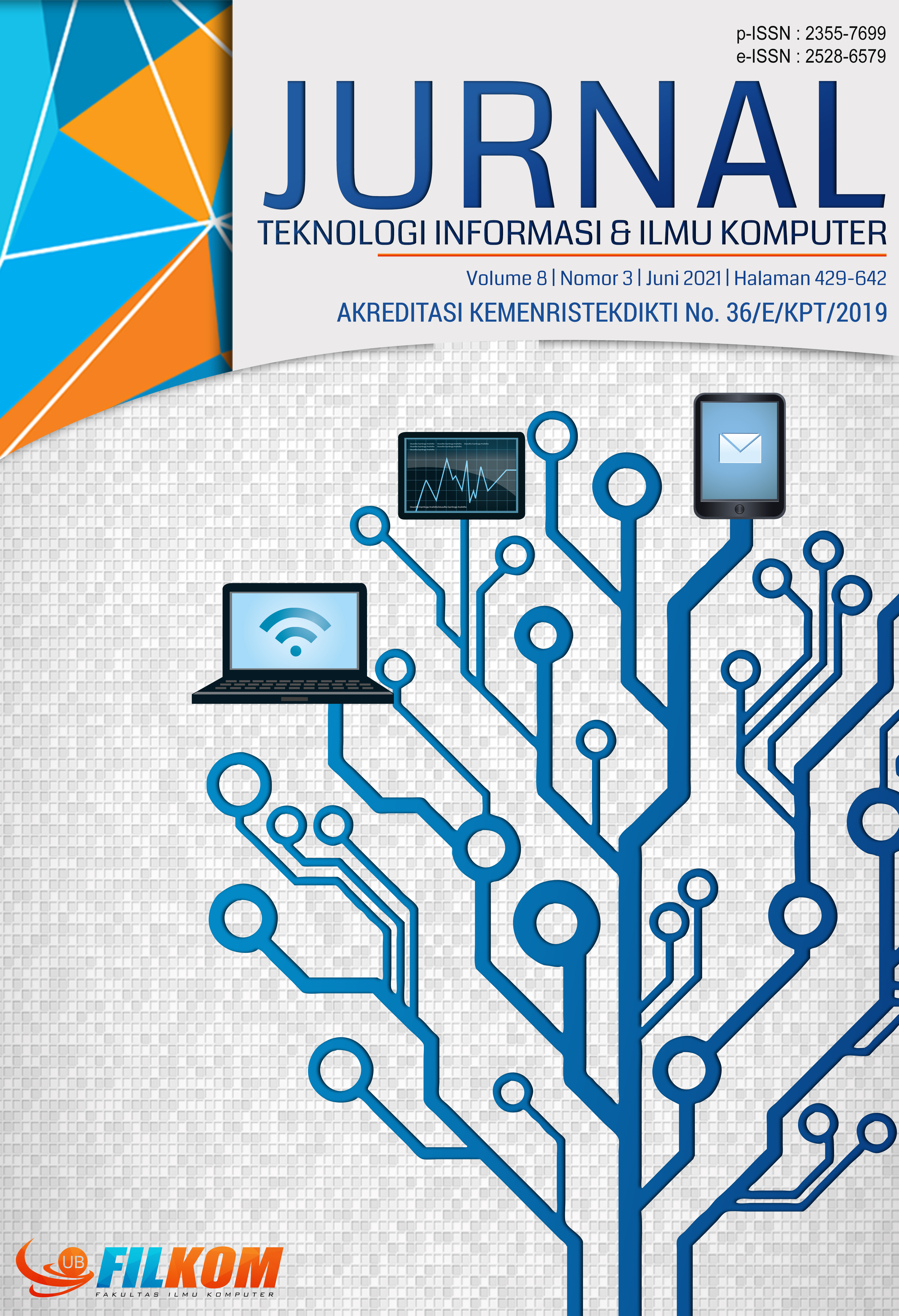Evaluasi Performasi Ruang Warna pada Klasifikasi Diabetic Retinophaty Menggunakan Convolution Neural Network
DOI:
https://doi.org/10.25126/jtiik.2021834459Abstrak
Semakin meningkatnya jumlah penderita diabetes menjadi salah satu faktor penyebab semakin tingginya penderita penyakit diabetic retinophaty. Salah satu citra yang digunakan oleh dokter mata untuk mengidentifikasi diabetic retinophaty adalah foto retina. Dalam penelitian ini dilakukan pengenalan penyakit diabetic retinophaty secara otomatis menggunakan citra fundus retina dan algoritme Convolutional Neural Network (CNN) yang merupakan variasi dari algoritme Deep Learning. Kendala yang ditemukan dalam proses pengenalan adalah warna retina yang cenderung merah kekuningan sehingga ruang warna RGB tidak menghasilkan akurasi yang optimal. Oleh karena itu, dalam penelitian ini dilakukan pengujian pada berbagai ruang warna untuk mendapatkan hasil yang lebih baik. Dari hasil uji coba menggunakan 1000 data pada ruang warna RGB, HSI, YUV dan L*a*b* memberikan hasil yang kurang optimal pada data seimbang dimana akurasi terbaik masih dibawah 50%. Namun pada data tidak seimbang menghasilkan akurasi yang cukup tinggi yaitu 83,53% pada ruang warna YUV dengan pengujian pada data latih dan akurasi 74,40% dengan data uji pada semua ruang warna.
Abstract
Increasing the number of people with diabetes is one of the factors causing the high number of people with diabetic retinopathy. One of the images used by ophthalmologists to identify diabetic retinopathy is a retinal photo. In this research, the identification of diabetic retinopathy is done automatically using retinal fundus images and the Convolutional Neural Network (CNN) algorithm, which is a variation of the Deep Learning algorithm. The obstacle found in the recognition process is the color of the retina which tends to be yellowish red so that the RGB color space does not produce optimal accuracy. Therefore, in this research, various color spaces were tested to get better results. From the results of trials using 1000 images data in the color space of RGB, HSI, YUV and L * a * b * give suboptimal results on balanced data where the best accuracy is still below 50%. However, the unbalanced data gives a fairly high accuracy of 83.53% with training data on the YUV color space and 74,40% with testing data on all color spaces.
Downloads
Referensi
AKTER, M., UDDIN, M. S. & KHAN, M. H., 2014. Morphology-based exudates detection from color fundus images in diabetic retinopathy. Dhaka, Bangladesh, IEEE International Conference on Electrical Engineering and Information & Communication Technology.
CASSIN, B. & SOLOMON, S., 1990. Dictionary of Eye Terminology. Gainesville, Florida: Triad Publishing Company.
CHAKRABARTY, N., 2018. A Deep Learning Method for the detection of Diabetic Retinopathy. Gorakhpur, India, 5th IEEE Uttar Pradesh Section International Conference on Electrical, Electronics and Computer Engineering (UPCON).
DEPARTMENT OF OPHTHALMOLOGY AND VISUAL SCIENCE, C. C. O. M., 2020. ophthalmology.med.ubc.ca. [Online] Available at: Available: https:// medicine.uiowa.edu/eye/ patient-care/imaging-services/color-fundus-photography. [Diakses October 2019].
DEPERLIOGLU, Ö. & KÖSE, U., 2018. Diagnosis of Diabetic Retinopathy by Using Image Processing and Convolutional Neural Network. Ankara, Turkey, IEEE 2nd International Symposium on Multidisciplinary Studies and Innovative Technologies (ISMSIT).
GOATMAN, K. A. et al., 2011. Detection of New Vessels on the Optic Disc Using Retinal Photographs. IEEE Transactions on Medical Imaging, 30(4), p. 972 – 979.
KUMAR, S. & KUMAR, B., 2018. Diabetic Retinopathy Detection by Extracting Area and Number of Microaneurysm from Colour Fundus Image. Noida, India, IEEE 5th International Conference on Signal Processing and Integrated Networks (SPIN).
MASOUD, A.-S., POURREZA, H. R. & BANAEE, T., 2016. A Novel Curvature-Based Algorithm for Automatic Grading of Retinal Blood Vessel Tortuosity. IEEE Journal of Biomedical and Health Informatics, 20(2), p. 586 – 595.
NG, E. . Y. K., ACHARYA, U. R., RANGAYYAN, R. M. & SURI, J. S., 2020. Ophthalmological Imaging and Applications. United States: CRC Press, Inc.
OSAREH, A., SHADGAR, B. & MARKHAM, R., 2009. A Computational-Intelligence-Based Approach for Detection of Exudates in Diabetic Retinopathy Images. IEEE Transactions on Information Technology in Biomedicine, 13(4), p. 535 – 545.
ROYCHOWDHURY, S., KOOZEKANANI, D. D. & PARHI, K. K., 2014. DREAM: Diabetic Retinopathy Analysis Using Machine Learning. IEEE Journal of Biomedical and Health Informatics, 18(5), p. 1717 – 1728.
SASONGKO, M. B. et al., 2017. Prevalence of Diabetic Retinopathy and Blindness in Indonesian Adults With Type 2 Diabetes. American Journal of Ophthalmology, Volume 181, pp. 79-87.
SEOUD, L. et al., 2016. Red Lesion Detection Using Dynamic Shape Features for Diabetic Retinopathy Screening. IEEE Transactions on Medical Imaging, 35(4), p. 1116 – 1126.
WOLIN, L. R. & MASSOPUST, L., 1967. Characteristics of the ocular fundus in primates. Journal of Anatomy, 101(4), p. 693–699.
ZHANG, L., LI, Q., YOU, J. & ZHANG, D., 2009. A Modified Matched Filter With Double-Sided Thresholding for Screening Proliferative Diabetic Retinopathy. IEEE Transactions on Information Technology in Biomedicine, 13(4), p. 528 – 534
Unduhan
Diterbitkan
Terbitan
Bagian
Lisensi

Artikel ini berlisensi Creative Common Attribution-ShareAlike 4.0 International (CC BY-SA 4.0)
Penulis yang menerbitkan di jurnal ini menyetujui ketentuan berikut:
- Penulis menyimpan hak cipta dan memberikan jurnal hak penerbitan pertama naskah secara simultan dengan lisensi di bawah Creative Common Attribution-ShareAlike 4.0 International (CC BY-SA 4.0) yang mengizinkan orang lain untuk berbagi pekerjaan dengan sebuah pernyataan kepenulisan pekerjaan dan penerbitan awal di jurnal ini.
- Penulis bisa memasukkan ke dalam penyusunan kontraktual tambahan terpisah untuk distribusi non ekslusif versi kaya terbitan jurnal (contoh: mempostingnya ke repositori institusional atau menerbitkannya dalam sebuah buku), dengan pengakuan penerbitan awalnya di jurnal ini.
- Penulis diizinkan dan didorong untuk mem-posting karya mereka online (contoh: di repositori institusional atau di website mereka) sebelum dan selama proses penyerahan, karena dapat mengarahkan ke pertukaran produktif, seperti halnya sitiran yang lebih awal dan lebih hebat dari karya yang diterbitkan. (Lihat Efek Akses Terbuka).















